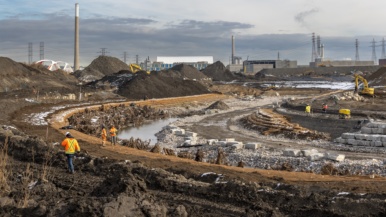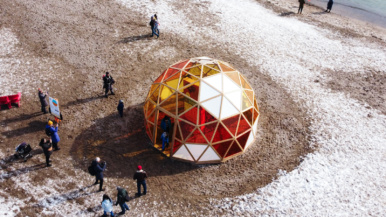
For the 600 soggy residents of the Toronto Islands, the summer of 2017 will forever be defined by sandbags, sump pumps and an intrepid fight to keep rising lake levels at bay
Like many people who grew up in Toronto, I spent my childhood summers picnicking on the Island and riding the Centreville merry-go-round. It was both serene and exotic—a fancy vacation for a family that couldn’t afford to take fancy vacations. Getting out on the water was always a thrill. So three years ago, when I got word that a woman was looking to rent out the top-floor unit in her white gingerbread cottage on Algonquin Island, I jumped. Walking up the lush garden path, lined with rustling lilacs and willowy grasses, it seemed like a Carrollian Wonderland.
Life on the Island necessitated new routines. After a few too many sprints to the ferry, I understood why all of the islanders rode bicycles. Carrying my groceries for the week down to the dock, across on the boat and along Cibola Avenue to home, I realized why they all had buggies on their bikes. The last ferry left the city at 11:30 p.m., which meant a significantly curtailed nightlife. There was no water taxi in the winter, and friends in the city became accustomed to leaving the door unlocked for me if I needed a couch to crash on once in a while.
Winter on the Island was like living in a snow globe. I watched teens play hockey on the lagoon near my house. I joined a group of elderly revellers with mugs of whiskey on the bridge to marvel at the supermoon. There was a pagan festival on Halloween and a Christmas market that drew crowds from the city. At the annual Wassail in the St. Andrew by-the-Lake chapel, I belted out carols, watched the Island kids turn into mummers and drank mulled wine. Life in this small town, just a 10-minute ferry ride from the big city, felt magical.
Eventually, though, the Island’s quirks morphed into annoyances. My friends got tired of me monopolizing their couches; I got tired of asking. There were nights I would have given up all of my worldly possessions to order a pizza. And, one spring morning, when the rain pelted me furiously on my waterlogged commute, I arrived at work so drenched that my co-workers scrounged up cast-off clothing for me to change into. When my landlady offered me a lease extension, I decided the trade-off wasn’t worth it.
That kind of thinking is blasphemy among the Island diehards. Many of them come from families that have inhabited the parkland for nearly 100 years. According to a land trust system, spouses and children get first right of refusal on a property that’s already in their family, which is why so many generations stay on the Island. “If a person says it’s exclusive, I’m afraid they’re right,” says Elizabeth Amer, a long-time resident and former city councillor.
The Toronto Islands initially weren’t islands at all, but a group of shifting sandbars created when currents carried -sediment from the Scarborough Bluffs westward and deposited them near the foot of the city. Locals called the area the Peninsula until 1858, when a furious storm severed the shore from the city and created a hole known as the Eastern Gap. The government has spent millions dredging the gap to make it deep enough for boats to travel through. The gunk they pulled from the bottom of the lake makes up the landfill that’s now the Leslie Street Spit. Parts of the Island are the result of dredging, too: Algonquin, where I used to live, is largely made from dredged sands. But this year’s floods could permanently change Island life: the spit now blocks natural detritus from running down the lake from the bluffs, preventing the Island from replenishing itself.

This summer, the Island’s 600-odd residents watched as water rose out of the lake and up from the ground, sloshing onto the streets. The rains came, relentless and for weeks, turning their bucolic paradise into a post-apocalyptic swamp. Trees sank into the sand, and entire beaches were submerged. Forty per cent of the Island was underwater, and the Island’s school had to relocate its students for May and June. Most of the amusement park on Centre Island is underwater. A peacock named Poseidon or Titanic, depending on who you ask, escaped from Far Away Farm and took up a perch high up on a resident’s balcony. Now more than 40,000 bright-orange sandbags barricade the shore. Pumps grind away at all hours. If it sounds like a dystopian fairy tale, that’s because it is. The water has risen almost three feet, and nobody knows when the levels will retreat. Some people are crying climate change; others say this is just the latest in a cycle of flooding that plagues the Island every few decades.
The residents, a plucky, tight-knit group, have had to work around the clock to keep the Island safe from the latest calamity, and tensions are high. Residents whispered about neighbours pumping water into the street instead of out further into the lake. Some accused their neighbours of flooding their yards, or propping the sewer grates up, which would lead to sewage coming up into the gardens like it did the last time the Island was hit with a serious flood, in 1973. In June, a dinghy was stolen from the marina at Centre Island. It still hasn’t turned up. The owner of the Island Cafe, a summertime restaurant, says he’s lost his patio and has had to lay off his employees.
I recently took the Ongiara ferry over to suss out the damage. It was eerie. Entire swaths of the land are forever changed. The beach where my boyfriend and I wiled away our first date was no more—everything after the bridge over to Snake Island was completely submerged. Church services had to be relocated, because the building, up on a small hill, was surrounded by a deep moat. An emergency pay phone meant for 911 calls stood in two feet of water, helping no one. I spat out mosquitoes as I walked—a new plague the islanders have to endure. But they’ve fought for years for their rights to the sandbar they call home. And if there’s anything they know how to do, it’s stand their ground. Here, five long-time islanders explain how they’re coping with the crisis.

Tanya Golden, 51
Art teacher and gardener
Years on the Island: 27
“Raincoats stopped being useful around the first week of May. One day, when it was really bad, a neighbour and I were standing in what used to be a park, with water up to our chests. One of the hoses pumping water off Bayview Avenue had flipped over, thanks to the force of the rains. We had to wade around and jimmy it out with a log before we hauled it back to its spot. It was suddenly normal to go out and get wet, and come back and change. I changed four times a day. We were like drowned rats.
“City staff brought sandbags over and the rain was lashing—I knew things were going to get bad. On May 8, the parks guys said we’d received a month’s worth of rain in three hours. I piled up sandbags every day, for at least two or three hours a day. You do what you have to do to protect your home and your community.
“My house is just a foot off the ground; it’s one of the lower houses on the Island. There’s a knot in the living room floor, so I created a dipstick I could use to measure the water below the house. At one point, there were seven inches of water under there. When I looked outside, I saw that we were lower than the lake level. That’s when I got worried about my place. If those sandbags along the shoreline breached, the water would come gushing into the house. They soaked for so long they weren’t orange anymore—they turned canary yellow.
“The Island elders didn’t panic, so neither did I. Plans were quickly put in place: the city had the ferry docked and stocked with cots in case we needed to hunker down on the boat for a night. I worked inside my house, putting everything that was sitting on the floor up on bricks or planks so that if the water came through the floorboards my furniture wouldn’t get destroyed. I’ve been taking my laundry to friends’ places—I don’t have a dryer, and I haven’t been able to hang my washed clothing outside. I still have more than 100 sandbags lining my house. The landscape designs of the future are going to include sandbags—pond features are out, water features are out. You heard it here first.”

Inese Gravlejs, 59
Psychotherapist
Years on the Island: 26
“My husband, Mike, and I are members of the Island emergency preparation committee. We usually deal with routine stuff: medical emergencies, fires or pest outbreaks. I grew up a girl scout, and Mike was a junior forest ranger, so we like to be prepared. We never expected to be facing something like this.
“The first week was miserable. Everyone was out in the pouring rain sandbagging their houses. The lake levels were rising fast, and we didn’t know how long it would last. We still don’t, really. People were starting to panic about whether we’d lose power. Since we’re on a sandbar, most of our houses don’t have basements, but we all have flooded crawl spaces; we had to remove our HVAC system. That first week, many people had water rising right up to their front steps and into their kitchens. Eventually, city staff brought thousands of sandbags on buggies across the Island.
“Since then, my brain hasn’t stopped. I wake up every morning before sunrise. There are always a gazillion details to deal with, like getting gloves for all our volunteers to protect them from bacteria in the water, or contributing to potluck meals for all of the sandbaggers who are coming to the Ward’s Island clubhouse for lunch and dinner. Mike says he’s having dreams about pumping water. Some people have started complaining—why weren’t we prepared? Couldn’t we have predicted that something like this would happen? But there’s no blueprint for a threat like this.
“It’s hard work, and everyone’s contributing. One guy bought a $1,000 pump that he’s letting everyone use for free. When our elderly neighbour got a soggy kitchen floor, a bunch of us dug out a trench around her house.
“Even the fire ants, the scourge of the Island, are fighting to survive. The other day, someone saw a chain of them linking arms on top of the water. The damn ants are trying to figure it out!
“Still, I think the city overreacted by closing the Island and not letting city dwellers come over to take in the damage. I understand that they want to keep everyone safe, but this is global warming right before your eyes. It’s important for people to see that.”

Jay Bascom
Retired insurance claims manager
Years on the Island: 71
“At the beginning, it rained so hard for so long. All of us were concerned. Later, I could see the groundwater rising and the lake water coming through the first sandbags. We were helpless. City and Conservation Authority crews were out digging trenches and installing pumps all down the streets. Warren Hoselton, the parks supervisor who looks after the Island, went above and beyond the call of duty, hiring a tugboat called Radium Yellowknife to ship sandbags from the Ward’s dock around to the face of Algonquin Island.
“In 1992, I had my house elevated 18 inches above the ground and put in a new foundation, so it’s relatively safe. But my yard is a swampland. My cat, Squeaks, is going a little crazy. She just sits at the back door and whines, trying to decide whether it’s worth the wet feet to go outside. I usually visit St. Lawrence Market on Fridays, but I can’t bike across the Island because of the high water levels.
“I could have packed up the cat and taken her to the city when the water rose. But I didn’t. My family has been on the Island for 100 years, and I was born here. I’ve seen a lot. I remember four major floods, going back to 1952. We got through those, and we’ll get through this.
“Some of the newbies over here are all in a big kerfuffle. They’re the first ones to start yelling about their HVAC systems in the crawl spaces. But they were warned not to put them under there. We live on a sandbar; we live on a giant sponge.
“A few winters ago, some coyotes came over the ice from the city and just stayed, killing many of the Island cats. They made their home in the dry meadow behind the Algonquin Island Association clubhouse. Now the meadow is underwater. We’re hoping that might drive them away. Rumour has it that several of them were seen swimming off the beach after the flooding began.
“I’ve gone out every day to the grate on the corner with a garden stake to make sure the drain isn’t clogged. You’re either born to love a place like this, or you’re not. I’ve had overnight guests who get terribly twitchy and upset when they hear the whistle of the last ferry. Most of us, especially on a crowded summer weekend when the place has been filled with tourists and noise, we hear that ferry whistle and think, ‘They’re gone,’ and we breathe a sigh of relief. Those of us who were born here would never leave except in a pine box.”

Elizabeth Amer, 79
Retired city councillor
Years on the Island: 60
“I first came to the Island with my mom and dad as a baby. We were visiting my grandparents, who’d moved onto one of the lots in 1919, back when Ward’s Island was still a tent site. I have a picture of myself on my grandma’s doorstep in my diaper. And I hope to be sitting out there in my diaper when I’m old.
“As soon as I graduated from high school, I moved in with my grandmother. My mom eventually moved to the Island, too, and I inherited this house from her in 1969. I live on Bayview Avenue, and my front window looks right onto the bay with a view of the city skyline. Now there’s a foot of swamp water all around my house. My garden is ruined. My lettuce and tomatoes are dead. My rhubarb is limp; I guess it doesn’t like being drowned. It sounds simple, but I just miss being outside.
“Our events—the annual Strawberry Social and the Blessing of the Bikes and the Boats—are cancelled because we can’t get to the church. We don’t have swarms of tourists roaming the Island like we normally would, and that’s nice, but no one else is roaming either.
“At least this year, the city is in it with us. The last time there was a flood like this, back in 1973, city workers dropped empty sacks at the ferry dock and we had to shovel 50 pounds of sand into each one ourselves, and drag them into position. We’re still sandbagging, but at least we’ve got double the manpower because they’re helping.
“Mayor John Tory suggested we might have to evacuate. If they said, okay, come to the Royal York Hotel and we’ll feed you, give you a bath and introduce you to a good-looking guy, maybe. But I’ve mobilized hundreds of people to protest eviction and demolition. I’ve faced off with cops. I’ve fought for 40 years to earn my right to stay on the Island. I’m sure there would be circumstances under which I could be forced to leave. But voluntarily? I’m not going anywhere.”

Joanna Kidd, 62
Environmental consultant
Years on the Island: 51
“May 10 was the day I knew we had a serious problem. The water was coming fast and relentless. I’m the grounds chair for the Queen City Yacht Club, and our clubhouse is the lowest and most vulnerable building on Algonquin Island. When water started filling the foyer floor, club members quickly built a sandbag barricade around the building. Two days later, bam—we had a breach, and for the second time in two days, six of us had to empty and drain the clubhouse. It was so disheartening.
“I had never slung a sandbag before this. But if anything happened to the club, I would be devastated. So we kept scrambling to pile them on, out there in the rain. And every time I thought we were okay for a little while, suddenly, the water would come through again. The lake just kept on rising.
“The area around the clubhouse was equipped with seven pumps, which the volunteers monitored 24 hours a day. We called ourselves the pump brigade. In the middle of the night, every night, volunteers would check the water levels, pour fuel into the pumps out of jerry cans, record their findings and slosh their way back home in the dark. At one point, we were pumping so much water out of the lawn that you could see streams jetting into Lake Ontario from the ferry.
“When the rain died down in June, some volunteers built catwalks around the clubhouse so we wouldn’t be wading in the water. It means some of our members can reach their boats and go sailing, too, which restores some normalcy to their lives. It’s too soon to tell if there will be major lasting damage, though we know we’ll have to replace some of the flooring and fix the track system that’s been displaced by the shifting ground below.
“I’ve been sailing on Lake Ontario my whole life. Sailors are used to a little adversity, we’re used to being wet. And I know water is a powerful force. But every time I think we have it beat, all of a sudden it knocks us down again.”





